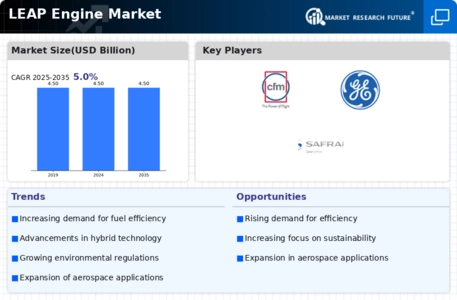Market Analysis
In-depth Analysis of LEAP Engine Market Industry Landscape
The Leap Engine market is undergoing dynamic changes fueled by the aviation industry's continuous pursuit of fuel efficiency, reduced emissions, and enhanced performance. Developed by CFM International, a joint venture between General Electric and Safran Aircraft Engines, the Leap Engine represents a significant advancement in aviation propulsion technology. The market dynamics of the Leap Engine are shaped by several key factors, reflecting the industry's ongoing commitment to innovation and sustainability.
One of the primary drivers influencing the Leap Engine market is the global aviation industry's focus on fuel efficiency and environmental sustainability. As airlines seek to reduce operating costs and comply with stringent emissions regulations, the Leap Engine stands out for its cutting-edge design and advanced materials. Its fuel-efficient capabilities contribute to lower carbon emissions, making it an attractive choice for airlines looking to modernize their fleets and adopt environmentally friendly technologies.
Technological advancements play a pivotal role in shaping the market dynamics of the Leap Engine. With features such as advanced materials, 3D-printed components, and innovative cooling technologies, the Leap Engine represents a leap forward in aircraft propulsion efficiency. The incorporation of these technologies results in improved fuel burn, increased durability, and overall enhanced performance, addressing the industry's demand for more sustainable and cost-effective solutions.
Market dynamics are also influenced by the increasing demand for single-aisle aircraft, particularly in the narrow-body segment. The Leap Engine is a powerplant option for popular aircraft models like the Boeing 737 MAX and the Airbus A320neo. The growth in air travel, especially in emerging markets, is driving the demand for fuel-efficient and high-performance engines, positioning the Leap Engine as a preferred choice for airlines seeking to optimize their fleets for both economic and environmental benefits.
Regulatory standards and emissions requirements significantly impact the Leap Engine market. The aviation industry faces stringent regulations aimed at reducing greenhouse gas emissions and improving overall environmental performance. The Leap Engine's compliance with these regulations, coupled with its fuel efficiency, positions it favorably in the market. Airlines are incentivized to adopt engines that not only meet current standards but also align with anticipated future regulatory requirements.
Market dynamics are further influenced by the competitive landscape within the aviation propulsion sector. The Leap Engine competes with other advanced engines, such as the Pratt & Whitney PW1000G, in the race for market share. Companies in the industry continually invest in research and development to introduce new technologies and features, aiming to differentiate their products and capture a larger share of the growing market for modern aircraft engines.
Economic factors, including fuel prices and global economic conditions, impact the market dynamics of the Leap Engine. Airlines consider not only the initial cost of acquiring and installing new engines but also the long-term operational savings in fuel consumption. Fluctuations in fuel prices and economic uncertainties can influence airlines' decisions regarding fleet upgrades and engine selections, impacting the overall demand for advanced propulsion systems like the Leap Engine.






Leave a Comment